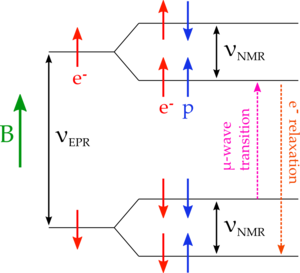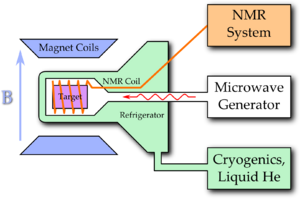Difference between revisions of "Solid Polarized Target"
From Hall A Wiki
(→Overview) |
(→Overview) |
||
| Line 1: | Line 1: | ||
==Overview== | ==Overview== | ||
| + | |||
| + | [[Image:DNP-diag1.png|300px|thumb]] | ||
| + | Our Dynamically Nuclear Polarized Target can provide greater than 90% proton polarization in a irradiated ammonia target sample in a 5T magnetic field and at around 1K. The basic operating principle involves leveraging the spin-spin coupling of a free electron in our material to the proton we wish to polarize. In a magnetic | ||
| + | |||
[[Image:DNP-Overview.png|300px|thumb]] | [[Image:DNP-Overview.png|300px|thumb]] | ||
| + | There are 5 basic ingredients which go into this target: a high magnetic field, a low temperature, a microwave system, an NMR system, and a suitable target material. We will briefly walk through these 5 building blocks, and what systems are necessary to provide them in the experimental hall. | ||
| + | |||
| + | ===Magnetic Field== | ||
==Training Materials== | ==Training Materials== | ||
Revision as of 15:41, 8 September 2011
Overview
Our Dynamically Nuclear Polarized Target can provide greater than 90% proton polarization in a irradiated ammonia target sample in a 5T magnetic field and at around 1K. The basic operating principle involves leveraging the spin-spin coupling of a free electron in our material to the proton we wish to polarize. In a magnetic
There are 5 basic ingredients which go into this target: a high magnetic field, a low temperature, a microwave system, an NMR system, and a suitable target material. We will briefly walk through these 5 building blocks, and what systems are necessary to provide them in the experimental hall.
=Magnetic Field
Training Materials
Links
University of Virginia Target Group Links:
Pertinent Papers:
- SOLID POLARIZED TARGETS FOR NUCLEAR AND PARTICLE PHYSICS EXPERIMENTS, DG Crabb, W Meyer

